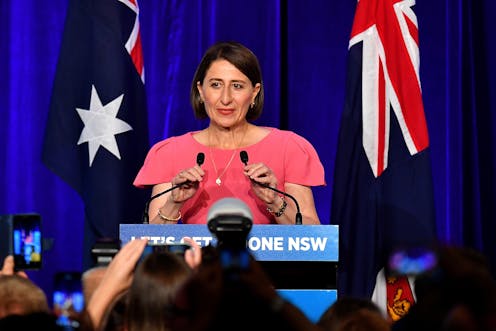Coalition wins a third term in NSW with few seats changing hands
- Written by Adrian Beaumont, Honorary Associate, School of Mathematics and Statistics, University of Melbourne

With 54% of the vote counted at the New South Wales election held today, the ABC is currently projecting 45 of the 93 lower house seats for the Coalition, 35 for Labor, three Greens, three independents and two Shooters, Fishers and Farmers. Five seats remain undecided. Coogee is the only current clear Labor gain from the Coalition.
Forty-seven seats are needed for a majority, but the Coalition is in a strong position to form a minority government if it falls short. This will be the Coalition’s third term in NSW. It is the first time the Coalition has won a third term in NSW since 1971; the last time the Coalition won a third term in state government in Australia was in 1980.
All crossbenchers in the current parliament retained their seats. The Greens won Newtown, Balmain and Ballina. The Shooters retained Orange, which they had won at a byelection, and gained Murray from the Nationals. Independents retained Sydney, Lake Macquarie and Wagga Wagga (also won at a byelection).
Read more: Low-key NSW election likely to reveal a city-country divide
The ABC’s projection of final primary votes are currently 41.7% Coalition (down 3.9% since the 2015 election), 33.4% Labor (down 0.7%), 9.9% Greens (down 0.4%) and 3.1% Shooters. If the projection is accurate, it is an indictment on Labor that their primary vote fell. The two party statewide result will not be available for a long time, but the Coalition probably won by about 53-47, a swing of about 1.5% to Labor.
If undecided seats are assigned to the current leader, the Coalition has a small majority with 48 of the 93 seats (down six since 2015), Labor has 36 seats (up two), the Greens three (steady), the Shooters three (up three) and independents three (up one).
Late campaign mishaps probably cost Labor in NSW. On March 18, Labor leader Michael Daley was revealed to have made comments in September 2018, before he became leader, that could be perceived as anti-Asian. On March 20, during a leaders’ debate, Daley could not recall details of funding for his party’s policies.
The final NSW Newspoll gave the Coalition a 51-49 lead, a one-point gain for the Coalition since eleven days ago. Primary votes were 41% Coalition (up one), 35% Labor (down one) and 10% Greens (steady). Reflecting his bad final week, Daley’s net approval plunged 14 points to -15, while Premier Gladys Berejiklian’s net approval dropped five points to +1. That Newspoll was taken March 19-21, and the momentum towards the Coalition appears to have carried over into the election results.
Two days before the 2015 Queensland election, Labor leader Annastacia Palaszczuk was unable to name the GST rate in an interview. Yet Labor ousted the LNP at that election on a massive swing.
I believe the difference between Queensland 2015 and NSW 2019 is that voters are more inclined to forgive politicians who make a mistake that is perceived to be out of character. Daley has only been the NSW Labor leader since November, and his anti-Asian video revealed something that voters did not like. It is probably more dangerous for a left-wing leader to be perceived as racist than a right-wing leader.
In the upper house, the electoral commission counted only above the line votes on election night for the Coalition, Labor, the Greens, One Nation, the Shooters, the Christian Democrats and Animal Justice. An “Others” column includes all above the line votes for parties on the ballot paper other than the above, all below the line votes and non-blank informal votes. We will not start to get a breakdown of Others until March 27.
21 seats were elected by statewide proportional representation, so a quota was 1/22 of the vote, or 4.55%. On current counts, the Coalition had 7.5 quotas, Labor 6.2, the Greens 2.0, One Nation 1.3, the Shooters 1.1, the Christian Democrats 0.5, Animal Justice 0.4 and all Others had a combined 3.0 quotas.
Some of the Others vote will be informal. When excluded from the count, the current named parties will increase their vote share, but this will particularly assist the stronger parties. Below the line votes tend to assist parties like the Greens and Animal Justice far more than Labor or the Coalition.
As the Coalition’s vote will increase after the exclusion of informal votes, they are set to win eight of the 21 seats (down three from 2011, the last time these seats were contested), Labor will win six (up one), the Greens two (down one), One Nation one (Mark Latham elected) and the Shooters one. Three seats remain undecided, and it is possible that one of the parties not included in the initial count, such as Keep Sydney Open or the Liberal Democrats, could be in a position to win a seat.
Currently the Coalition has 20 of the 42 upper house seats. With a three-seat loss, they will drop to 17, and need more assistance from other parties to pass legislation.
Read more: NSW election likely to be close, and Mark Latham will win an upper house seat
In the lower house, It was a great night for the Shooters, who retained Orange and gained both Barwon and Murray from the Nationals. The ABC currently lists two seats as in doubt, with the Coalition ahead in both Dubbo and East Hills. Lismore is listed as a Labor gain from the Nationals, but the Greens could overtake Labor in the race to finish second, and would probably then defeat the Nationals on Labor preferences.
Authors: Adrian Beaumont, Honorary Associate, School of Mathematics and Statistics, University of Melbourne
Read more http://theconversation.com/coalition-wins-a-third-term-in-nsw-with-few-seats-changing-hands-113035





